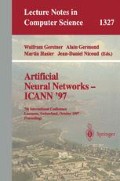Abstract
This article summarizes three examples of how the cerebral cortex achieves analog coherence and complementary fusion in its processing of visual information. Analog coherence refers to the need to reconcile two processing capabilities that often seem to be at odds. The brain needs analog sensitivity to distributed visual data to measure the relative importance of different combinations of features. It needs coherent processing of analog data to actively select the correct data grouping while suppressing less active groupings, yet coherent processing tends to be binary processing. This article suggests how the visual cortex balances both tendencies to achieve their best properties in examples of form and motion grouping. The article also suggests how the complementary strengths of form and motion processing are merged through form-motion interactions.
Preview
Unable to display preview. Download preview PDF.
References
Baloch, A.A. and Grossberg, S.: A neural model of high-level motion processing: Line motion and formotion dynamics. Vis. Res. (1997) in press.
Chey, J., Grossberg, S., and Mingolla, E.: Neural dynamics of motion grouping: From aperture ambiguity to Object speed and direction. J. Opt. Soc. Am., A (1997) in press.
Chubb, C. and Sperling, G.: Two motion perception mechanisms revealed through distance-driven reversal of apparent motion. Proc. Nat. Ac. Sciences-USA 86 (1989) 2985–2989
Ferster, D. and Lindström, S.: An intracellular analysis of geniculo-cortical connectivity in area 17 of the cat. J. Physiol. 342 (1983) 181–215
Francis, G. and Grossberg, S.: Cortical dynamics of form and motion integration: Persistence, apparent motion and illusory contours. Vis. Res. 36 (1996) 149–173
Gilbert, C.D. and Wiesel, T.N.: Morphology and intracortical projections of functionally characterized neurons in the cat visual cortex. Nature 280 (1979) 120–125
Grosof, D.H., Shapley, R.M., and Hawken, M.J.: Macaque V1 neurons can signal “illusory” contours. Nature 365 (1993) 550–552
Grossberg, S.: Contour enhancement, short term memory, and constancies in reverberating neural networks. Studies Appl. Math. 52 (1973) 217–257
Grossberg, S.: Adaptive pattern classification and universal recoding, 11: Feedback, expectation, olfaction, and illusions. Bio. Cyber. 23 (1976) 187–202
Grossberg, S.: How does a brain build a cognitive code? Psych. Rev. 87 (1980) 1–51
Grossberg, S.: Why do parallel cortical systems exist for the perception of static form and moving form? Percep. Psych. 49 (1991) 117–141
Grossberg, S.: 3-D vision and figure ground separation by visual cortex. Percep. Psycho. 55 (1994) 48–120
Grossberg, S.: The attentive Brain. Am. Sci. 83 (1995) 438–449
Grossberg, S. and McLoughlin, N.: Cortical dynamics of 3-D surface perception: Binocular and half-occluded scenic images. Neural Networks (1997) in press
Grossberg, S. and Mingolla, E.: Neural dynamics of perceptual grouping: Textures, boundaries, and emergent segmentations, Perc. Psycho. 38 (1985) 141–171
Grossberg, S, Mingolla, E., and Ross, W.D.: Visual brain and visual perception: How does the cortex do perceptual grouping? Tr. Neurosci. 20 (1997) 106–111
Grossberg, S. and Rudd, M.E.: A neural architecture for visual motion perception: Group and element apparent motion. Neural Networks 2 (1989) 421–450
Grossberg, S. and Rudd, M.E.: Cortical dynamics of visual motion perception: Short-range and long-range apparent motion. Psych. Rev. 99 (1992) 78–121
Hirsch, J.A. and Gilbert, C.D.: Synaptic physiology of horizontal connections in the cat visual cortex. J. Neurosci. 11 (1991) 1800–1809
Kapadia, M.K., Ito, M., Gilbert, C.D., and Westheimer, G.: Improvement in visual sensitivity by changes in local context: Parallel studies in human observers and in V1 of alert monkeys. Neuron 15 (1995) 843–856
Lesher, G.W. and Mingolla, E.: The role of edges and line-ends in illusory contour formation. Vis. Res. 33 (1993) 2253–2270
Liu, Z., Gaska, J.P., Jacobson, L.D., and Pollen, D.A.: Vis. Res. 32 (1992) 1193–1198
Lu, Z.-L. and Sperling, G.: Human visual motion architecture. Cur. Dir. Psych. Sci., 5 (1996) 44–53
McGuire, B.A., Gilbert, C.D., Rivlin, P.K. and Wiesel, T.N.: Targets of horizontal connections in macaque primary visual cortex. J. Comp. Neurol. 305 (1991) 370–392
McLoughlin, N.P. and Grossberg, S.: Cortical computation of stereo disparity. Vis. Res., (1997) in press
Murphy, P.C. and Sillito, A.M.: Corticofugal feedback influences the generation of length tuning in the visual pathway. Nature 329 (1987) 727–729
Murphy, P.C. and Sillito, A.M.: Functional morphology of the feedback pathway from area 17 of the cat visual cortex to the lateral geniculate nucleus. J. Neurosci. 16 (1996) 1180–1192
Liu, Z., Gaska, J.P., Jacobson, L.D., and Pollen, D.A.: Vis. Res. 32 (1992) 1193–1198
Redies, C., Crook, J.M., and Creutzfeldt, O.D.: Neuronal responses to borders with and without luminance gradients in cat visual cortex and dorsal lateral geniculate nucleus. Exp. Brain Res. 61 (1986) 469–481
Shipley, T.F. and Kellman, P.J.: Strength of visual interpolation depends on the ratio of physically specified to total edge length. Percept. Psychophys. 52 (1992) 97–106
Sillito, A.M., Jones, H.E., Gerstein, G.L., and West, D.C.: Feature-linked synchronization of thalamic relay cell firing induced by feedback from the visual cortex. Nature 369 (1994) 479–482
Soriano, M., Spillmann, L., and Bach, M.: The abutting grating illusion. Vis. Res. 36 (1993) 109–116
von der Heydt, R., Peterhans, E., and Baumgartner, G.: Illusory contours and cortical neuron responses. Science 224 (1984) 1260–1262
Weber, J., Kalil, R.E., and Behan, M.: Synaptic connections between cortico geniculate axons and interneurons in the dorsal lateral geniculate nucleus of the cat. J. Comp. Neurol. 289 (1989) 156–164
Author information
Authors and Affiliations
Editor information
Rights and permissions
Copyright information
© 1997 Springer-Verlag Berlin Heidelberg
About this paper
Cite this paper
Grossberg, S. (1997). Perceptual grouping and attention during cortical form and motion processing. In: Gerstner, W., Germond, A., Hasler, M., Nicoud, JD. (eds) Artificial Neural Networks — ICANN'97. ICANN 1997. Lecture Notes in Computer Science, vol 1327. Springer, Berlin, Heidelberg. https://doi.org/10.1007/BFb0020265
Download citation
DOI: https://doi.org/10.1007/BFb0020265
Published:
Publisher Name: Springer, Berlin, Heidelberg
Print ISBN: 978-3-540-63631-1
Online ISBN: 978-3-540-69620-9
eBook Packages: Springer Book Archive

